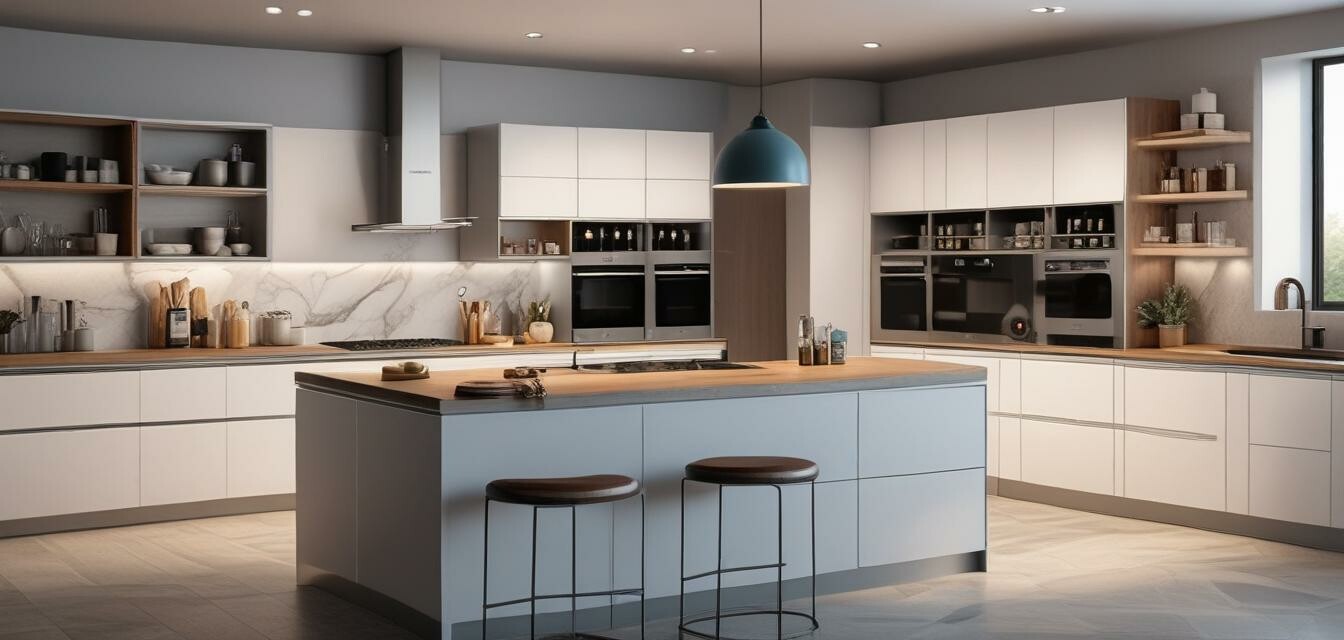
Kitchen Design Trends: Integrating Smart Tech in 2025
- Smart technology is revolutionizing kitchen design.
- Focus on aesthetics while enhancing functionality and convenience.
- Sustainable and energy-efficient solutions are essential trends.
- Integration of smart appliances streamlines cooking processes.
- Customizable and modular designs offer versatility in modern kitchens.
The kitchen is not just a place for cooking; it’s the heart of the home. As we approach 2025, integrating smart technology into kitchen design is becoming a key trend. This evolution not only enhances the functionality of kitchens but also promotes a seamless aesthetic that appeals to today’s homeowners. In this article, we'll explore the latest trends in kitchen design that incorporate smart technology, focusing on aesthetics, functionality, and convenience in modern cooking spaces.
1. The Rise of Smart Appliances
Smart appliances are no longer a luxury; they are becoming a standard feature in modern kitchens. These devices offer connectivity, allowing users to control them remotely or automate tasks.
- Smart ovens: Preheat remotely, set cooking times, and receive notifications when your meal is ready.
- Smart refrigerators: Monitor food inventory, create shopping lists, and even suggest recipes based on the ingredients available.
- Smart dishwashers: Optimize cleaning cycles based on load size while being more energy-efficient.
Key benefits of smart appliances
| Appliance Type | Key Benefits |
|---|---|
| Smart Ovens | Remote operation, precision cooking, safety features. |
| Smart Refrigerators | Inventory tracking, meal planning, reduced food waste. |
| Smart Dishwashers | Energy efficient, smart cycles, convenience. |
2. Sustainable Design Choices
As sustainability becomes an increasingly vital concern for homeowners, integrating energy-efficient appliances into kitchen design is paramount. Those who prioritize eco-friendly features are not only helping the planet but are also reducing utility bills.
- Energy-efficient appliances: Look for the ENERGY STAR label to ensure your appliances save energy.
- Water-saving fixtures: Install touchless faucets or low-flow fittings to conserve water.
- Recycled materials: Use surfaces made from recycled glass or reclaimed wood to minimize your environmental footprint.
Trends in sustainable kitchen design
| Feature | Advantages |
|---|---|
| Energy-efficient Appliances | Lower energy consumption and costs. |
| Low-flow Faucets | Reduces water usage, eco-friendly. |
| Recycled Surfaces | Stylish aesthetics, environmentally responsible. |
3. The Importance of Aesthetics
While functionality is critical, the visual appeal of a kitchen cannot be overlooked. In 2025, we will see trends that merge technology with style.
- Seamless design: Integrate appliances with cabinetry for a streamlined look.
- Bold colors and textures: Use a mix of materials like wood, metal, and stone to create depth and interest.
- Smart lighting: Incorporate adjustable LED lighting to enhance ambiance and efficiency.
Aesthetic trends to watch for
Pros
- Enhanced style and modern look.
- Customization options for unique spaces.
- Increased home value.
Cons
- Potentially higher initial costs.
- Some smart features may require Wi-Fi or an app.
4. Customization and Modular Design
Homeowners today want kitchens that reflect their personality. Customizable designs allow for personal touches while maintaining a smart, functional space.
- Modular cabinetry: Offers flexibility in layout and design.
- Personalized finishes: Choose colors and materials that suit your style.
- Smart storage solutions: Innovative designs that maximize space and minimize clutter.
Benefits of customizable kitchen elements
| Feature | Benefit |
|---|---|
| Modular Cabinetry | Flexible for any space or layout. |
| Personalized Finishes | Reflects individual styles and aesthetics. |
| Smart Storage | Efficient organization and easy access. |
5. Future-Proofing Your Kitchen
Updating your kitchen for the future means investing in technology and design that can adapt. Here are some key considerations:
- Integration with smart home systems: Keep your kitchen connected with home automation systems.
- Scalable technology: Choose appliances that can be easily upgraded.
- Trendy designs: Opt for timeless designs that will not go out of style quickly.
By incorporating these future-proofing strategies, homeowners can ensure their kitchens remain relevant for years to come.
Tips to Consider When Designing a Smart Kitchen
- Prioritize features that enhance daily tasks.
- Explore various smart technology options.
- Design for flexibility to allow for future changes.
- Keep an eye on upcoming trends to stay ahead.
- Incorporate energy-efficient and sustainable features for long-term savings.
As we look towards 2025, integrating smart technology into kitchen design is not just about convenience; it encompasses a complete transformation of aesthetics, functionality, and sustainability. Understanding these emerging trends will empower homeowners to make informed choices as they upgrade their kitchen spaces. For more insights and updates on the latest in high-tech kitchen appliances, be sure to visit our News and Trends section.